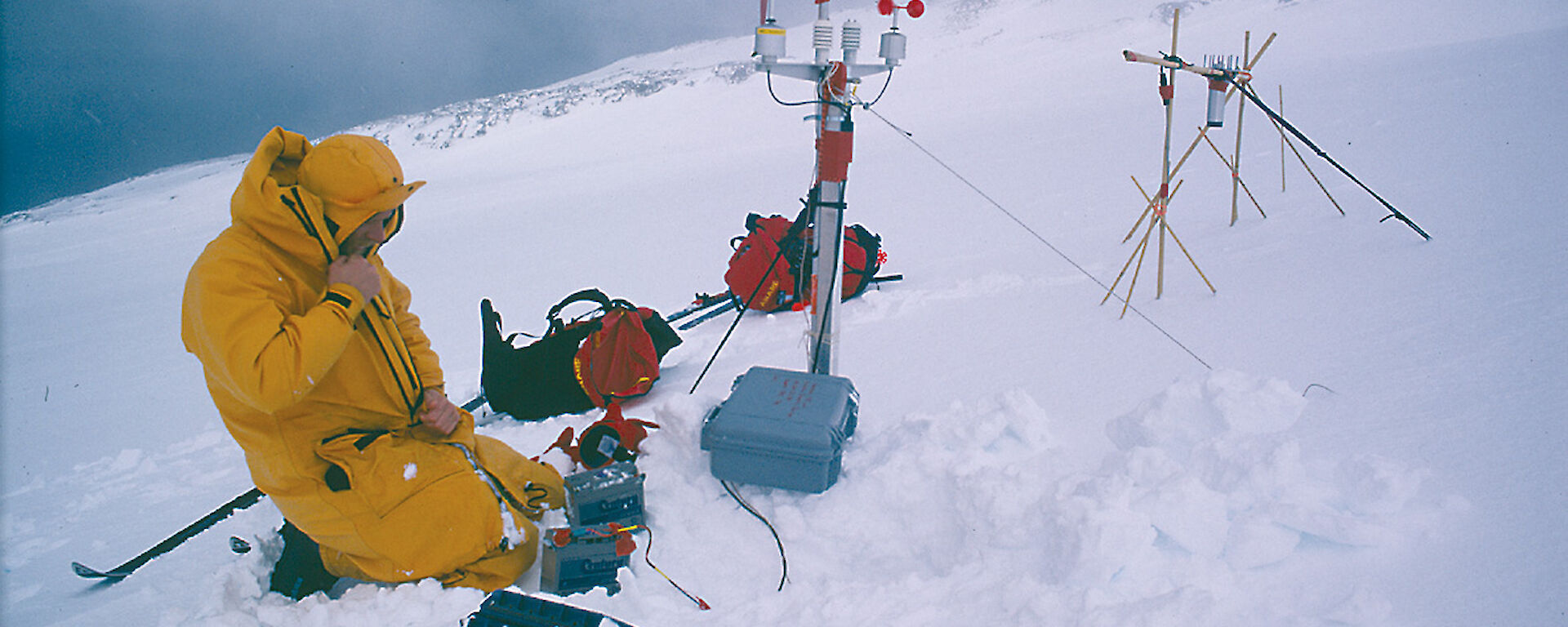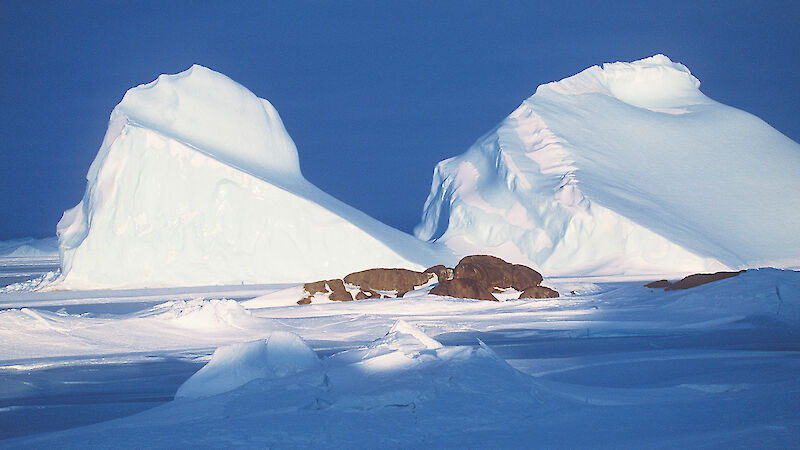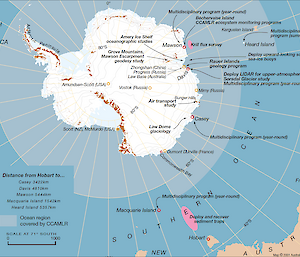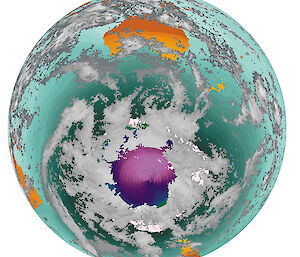“We stumble and struggle through the Stygian gloom; the merciless blast – an incubus of vengeance – stabs, buffets and freezes; the stinging drift blinds and chokes” – Sir Douglas Mawson, Home of the Blizzard, 1915
Sir Douglas Mawson’s sojourn in the eastern part of Antarctica marked the start of Australia’s national scientific expeditions to the southern continent. Over the years, the reasons for a national presence have evolved and today Antarctica is a continent set apart for peace and science. Generations of Australian scientists have fought the incubus of vengeance to the point where Australia's science program in the Antarctic is as sophisticated as that carried out anywhere; indeed the extreme nature of the environment has spawned the development of novel and ingenious ways of doing things. The success of the Australian program comes from blending the spirit of those who crave to face Antarctica's challenges with scientific and engineering ingenuity. Sir Douglas could hardly have dreamed of the program we are running in the 21st century, but I think he would be proud of it.
What we have learned about the natural sciences in Antarctica over the last forty years or so is that Antarctica is not simply a far distant and remote place, with a climate that makes a challenge of the simplest of activities. We now know it is an integral part of Planet Earth generating much of Australia’s weather, powering currents in the world’s great oceans, and perhaps being the canary in the polluted earth’s coal mine. Scientifically speaking, Antarctica has ceased to be an interesting oddity and now takes a central place in our understanding of major global phenomenological problems.
This article looks at three areas of the modern Australian science program that address the biggest of global issues of our time, and looks forward to the future.
Climate science
The problems with the world’s climate are becoming increasingly apparent. Unequivocal evidence exists of a rise in carbon dioxide levels during the past 200 years to unprecedented levels. Almost certainly this is the result of man’s activities. Australian work on the analysis of an ice core, taken from the icecap at Law Dome near Casey Station, is confirming data from other Antarctic ice analyses and assisting us in drawing an accurate picture of the history of Antarctic climate. The Australian core is particularly significant because it comes from a region with high precipitation, allowing a high resolution of the climate over the past 80,000 years. So good is the record that chemical markers from the air trapped in the ice allow us to pinpoint ancient volcanic eruptions, and trace the history of the world’s biological productivity.
There is no doubt that climate is changing. An international study, Regional Sensitivity to Climate Change, has recently been established, with Australian scientists taking a leading role. Climate change has measurable consequences. Changes in the distribution of plant species and their microhabitats can be used to make predictions about the future, and changes in the rates at which genetic mutations occur gives us a clue about how climate change is a factor in evolution.
Warming of the earth’s surface and its lower atmosphere leads to cooling in the upper atmosphere. This, in turn, leads to an increase in high-altitude ice-clouds that provide the substratum upon which the chemical reactions for the breakdown of ozone occurs. The ozone hole over the Antarctic is now a closely monitored international signal of global health but we do not know enough about the climatology of the middle and upper atmosphere.
High above the earth, between 80 and 100 km in a region that includes the mesopause, the evidence is that the coldest region of the atmosphere (cooler than –140°C) is cooling more dramatically than expected. Cooling rates of 0.7°C per year have been reported from northern hemisphere measurements. It has also been observed that noctilucent or ‘night shining’ ice-clouds that form at an altitude of around 83 km, mainly in summer in polar regions, are increasing in occurrence and extent. Statistics on southern noctilucent cloud occurrence are sparse and trends are presently unknown. Either increased water vapour at these altitudes resulting from enhanced methane release at ground level, or enhanced cooling, have been postulated as reasons for their increase. Monitoring of this extreme climate region in Antarctica to find out what is happening is an important step in our understanding of climate change.
Physicists at the AAD and University of Adelaide have developed a novel ground-based instrument that accurately profiles temperatures in the stratosphere and mesosphere. The instrument, known by its acronym LIDAR (Light Detection and Ranging), is essentially an optical form of radar. The LIDAR sends pulses of green laser light into the atmosphere in a narrow beam. Atmospheric gases along the beam scatter some of the light back to the instrument where it is collected by a large telescope. The altitude from which the scattered light is received is determined by timing how long it takes the signal to arrive after each laser pulse. The scattered light carries with it a signature of the amount of vibration and hence temperature of the gases in the form of a slightly larger range of colours. An optical device known as a Fabry-Perot spectrometer is used to very precisely measure the range of colours in both the outgoing and collected light. From this information a determination can be made of the average temperature of any point from the ground to about 90km altitude. Measurements are also made of the speed and wind direction along the LIDAR beam. The instrument was installed at Davis in late 2000 to investigate the climate of the polar atmosphere at high altitudes to improve global climate prediction.
Sustainable harvesting of the Southern Ocean
The Southern Ocean is a vast and seemingly limitless place. Once the home to vast numbers of whales and seals it has changed radically in living memory. We know very little about the marine ecosystem close to the Antarctic continent yet continue to rely heavily upon it, and we expect to continue to catch fish and seek out new fisheries as the old are depleted. Australia takes a leading role in the scientific underpinning of the decisions made by the Commission for the Conservation of Antarctic Marine Living Resources (CCAMLR) – the only international convention to which Australia is host. Last year, Australia completed a survey of pack-ice seals (crabeater, Weddell, Ross) around one quarter of the Antarctic coastline. This was a complex and tricky activity that required precision flying and ship navigation, and sophisticated computer software for recording – as well as some luck with the weather! The data are currently being processed and they will give, for the first time ever, an accurate picture of the extent of the pressures that predators exert on krill, and with which humans are in competition.
But predators of krill are only one component, albeit a highly visible one, of a complex ecosystem. A massive interdisciplinary study has been undertaken by Australian Antarctic Division scientists with involvement from those at CSIRO, the Antarctic CRC, IASOS, Tokyo Fisheries University, Flinders University and the University of Washington. This has focused on the biology and oceanography of 3,500 km of ice-edge zone from 80 to 150ºE. Far from being a homogeneous pond, the most productive waters occur in two main areas: coastal and shelf areas south of the southern boundary of the Antarctic Circumpolar Current, and regions where the sea ice extent in winter is greatest. Here the concentrations of microscopic marine organisms support vast swarms of krill, which themselves support an abundance of penguins, seabirds, seals and whales. In the east of the AAT, where the winter extent of sea ice is minimal, the fauna is dominated by the jelly-blobs of salps; apparently inedible creatures able to support only an impoverished food chain. These data help us to set appropriate krill catch-limits and to predict the possible biological consequences of global warming which may further reduce the sea ice extent – already thought to have shrunk by almost 30% in the last half century.
Ocean circulation
The circulation patterns of the southern oceans are far from simple. Driven by winds of the howling westerlies and screaming fifties, the Antarctic Circumpolar Current flows from west to east. This current is the longest and has the largest flow in the world. It connects the deep flows of the Atlantic, Indian and Pacific Oceans as part of the global thermohaline circulation. These raging gales set up the heavy swells and switchback seas that have laid low many an Antarctic traveller! But Antarctica generates its own particular wind patterns. The cold katabatic winds that flow down to the coast from the icy interior – Mawson’s incubus – gather speed until they burst out onto the ocean with ferocious force. A study conducted during the winter of 1999 at an ice-free area off the Mertz Glacier showed that the wind scoured away the ice as it was forming and transported it up to 90km in a day. The rate of removal of ice as it was forming amounted to an annual production of about 10 metres – far higher than in areas where the katabatic winds are less severe. Since only freshwater freezes into ice, the water that remains becomes increasingly salty, and accordingly becomes denser. Sinking to lower depths, it spills over the edge of the continental shelf and onwards down into the abyssal depths. From there it heads north, gradually warming and rising when it is well into the northern oceans. Cold water carries more oxygen that warm, so as it rises it re-oxygenates the upper layers. Dissolved nutrients lying in the abyssal deep are brought to the surface, providing the nutrient substratum for swarms of microscopic plankton. The Mertz polynya study brought together AAD glaciologists, CRC and CSIRO oceanographers, and marine biologists, and made great use of remote sensing and satellite technologies. It is opening up new windows on ice, wind, ocean currents and biological productivity.
What of the future?
The future for Antarctic science is an exciting one. New technologies, particularly in the field of remote sensing, will begin to contribute data on a range of phenomena including ocean productivity and ice cap thickness. LIDAR, and the new TIGER radar (situated in Tasmania but beaming out over eastern Antarctica) will contribute data on climate change in the mesopause and disturbances in space weather, respectively. Repeated surveys of plant abundance and distribution on the continent and on Heard Island, where invertebrate distribution is also being measured, will give an indication of the speed of climate change, now thought by the Inter-Governmental Panel on Climate Change to be more rapid than previously forecast. Repeated ocean traverses will indicate the extent to which seawater temperature and chemistry are changing, and large-scale marine biodiversity surveys will continue to link biological and physical change.
The next decade will see Australia making progress in cleaning up abandoned work sites, and developing the technologies necessary for handling increasingly friable drums and tanks.
But perhaps the most exciting outcome of the next decade will come from analyses of multi-year/decadal trends that lie hidden in the long-term data sets that are now accumulating. As automation and remote sensing technology are more and more widely and universally used, the flow of data about Antarctic phenomena will quickly become a torrent. Already many scientists are showing interest in a phenomenon known as the Antarctic Circumpolar Wave, a wave of anomalies in sea surface temperatures and surface air pressures, that appears to take about eight years to sweep right around Antarctica. Two waves are rolling around, so every four years or so each location experiences the changed conditions. Does this fascinating phenomenon influence biological productivity, or the amount of water locked in the vast ice cap, or the periodic failure to live to fledging age of Adélie chicks, or the extent of winter sea ice? We do not know yet, but in ten years we might.
I am grateful to Drs Nathan Bindoff, Ray Morris and Steve Nicol for their help with this article.





